#eurasia pack
Text
youtube
Announced today: the Eurasia Animal Pack!
Featuring the Wisent (a type of bison), Wild Boar, Mute Swan, Sloth Bear, Wolverine, Saiga (an antelope), Takin (a cow...goat...?), and the Hermann's Tortoise.
This is such a cool selection of animals, and all alongside a free update as well. Releasing December 13th - who's excited?
#forgive me calling the takin a cow-goat I just wanted a way to describe it for people who don't know what it is (me)#also the saiga has the coolest nose I gotta post a picture#planet zoo#eurasia pack#dlc#news#Youtube
47 notes
·
View notes
Text

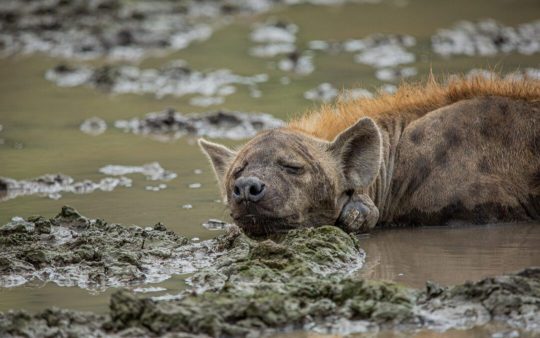

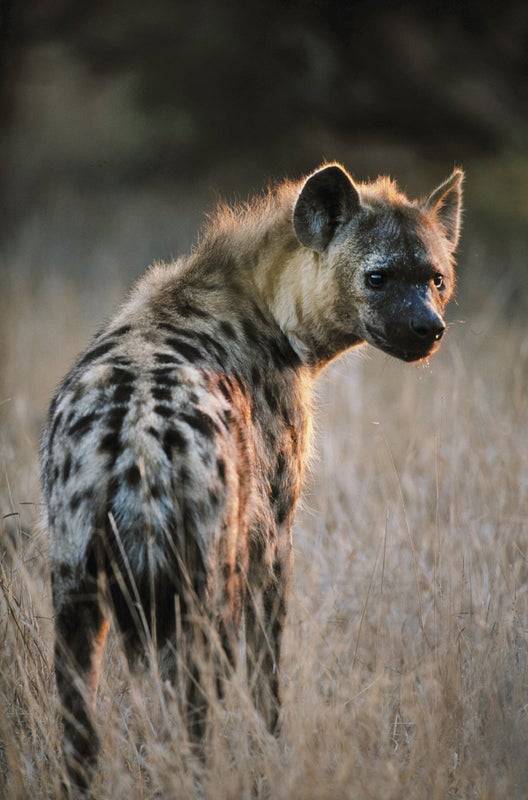
Say Hi to the Spotted Hyena
The spotted hyena is also known, perhaps most famously, as the laughing hyena (Crocuta crocuta). This species once ranged throughout Eurasia, but following the end of the Ice Age was restricted to sub-Saharan Africa. Today they can be found in many types of dry, open habitat, including savannah, semi-desert, and mountain forests. At times, the spotted hyena may also enter urban areas in search of food.
Unlike other hyenas, Crocuta crotuta is a predator, not a scavenger. They most commonly prey on wildebeast, but they may also hunt zebra, gazelles, Cape buffalo, and warthog. In addition, desperate times may cause packs to hunt on more dangerous prey such as young hippopotamus, giraffe, and rhinoceros. Spotted hyenas have incredible endurance, reaching speeds of 60 km/hr (37 mph); a single chase can last over 24 km (14 miles). When live prey is scarce, the laughing hyena can also turn to carrion, as well as snakes and ostrich eggs. In turn, this species may be killed by lions, though this may be motivated more by competition than prey drive.
Spotted hyena females are typically larger than males, weighing 44.5–67.6 kg (98–149 lb) to the males' 40.5–69.2 kg (89.3–153 lb). The height range for both sexes lies between 70–91.5 cm (27.6–36.0 in). In addition, female laughing hyena are somewhat famous for their masculinated genetalia; the clitoris is enlarged, resembling a penis, and is accompanied by sacs filled with fibrous tissue that resemble a scrotum. As the name implies, the coat is light brown with darker spots over most of the body. Because the species has such a wide diet, it has was is considered to be the strongest in relation to size of any mammal. The bite force is stronger than that of a brown bear, and can exert a force of 4,500 newtons-- enough to crush bone.
The laughing hyena is a highly social animal, and individuals live in communities up to 80 strong; size largely depends on prey availability and whether or not the group migrates. A clan territory can be anywhere from 40 km (24 mi) to 1000 (621mi) squared. Females dominate the males, and a pack is usually led by a matriarch. Hierarchies are strictly enforced, and positions are primarily inherited through birth and transferred through death. In addition, one's rank is maintained and recognized through social alliances and their contributions to the clan rather than size or dominance displays. The entirety of the clan comes together most often when defending a territory, gathering at the communal den, or at a kill; however, these kills are more commonly produced from smaller offshoots of the clan.
Crocuta crotuta can breed year-round, though mating is at its peak during the wet season from April to June. Members of both sexes pair indiscriminately with multiple mates, both within their clan and without. To offer himself, the male performs a mating ritual in which he lowers himself to the ground before the female, and retreats if any aggression is shown. Once impregnated, the female carries for about 110 days before giving birth to two cubs-- three is fairly rare. Weaning takes another 14 to 18 months, during which time cubs learn to hunt and defend the clan, as well as establish their place in the social hierarchy. Sootted hyenas reach maturity at about 3 years old, and can live an average of 12 years in the wild, though individuals as old as 25 have been recorded.
Conservation status: The spotted hyena has been determined Least Concern by the IUCN. However, outside protected areas the population is declining due to deforestation and hunting as a nuisance species.
If you like what I do, consider leaving a tip or buying me a ko-fi!
Photos
Augusto Bila
Elise Pianegonda
Evie Davidian
Art Wolfe
#spotted hyena#Carnivora#Hyaenidae#hyenas#carnivores#mammals#savannahs#savannah mammals#grasslands#grassland mammals#scrubland#scrubland mammals#africa#sub saharan africa#animal facts#biology#zoology#requested
175 notes
·
View notes
Text
The Cataphract - Inspired by Ancient Cavalry
Armored Core Fun Facts:
We first meet the heavily armored and imposing Cataphract in the story trailer for Armored Core VI, and then battle it a few times in-game. This beast, packing a hell of a punch and heavily armored, does justice to its historical inspiration.
The word "Cataphract" comes from the Greek "kataphraktos" (κατάφρακτος) meaning "completely enclosed" or simply "armored", and referred to heavy cavalry of Iranian origin known for both horse and rider being covered in scale armor, creating a very tanky unit that was hard to oppose.
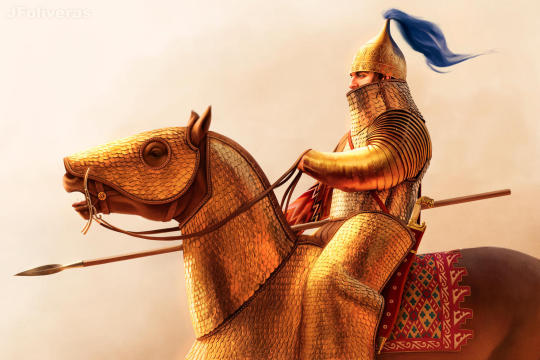
These heavy cavalry were known for crashing into opposing infantry and scattering enemy soldiers, taking advantage of their heavy armor and weapons to send lightly armored infantry and cavalry into disarray and mow them down if possible, and though they originated around Iran, their use spread throughout Eurasia and North Africa.
The Cataphract in Armored Core VI is similarly beastly and intimidating, and you can only imagine what light work it would make of garden variety MTs based on how much trouble it causes for even small groups of ACs, and even the player (depending on your build).

#armored core#armored core 6#armored core vi#armored core series#fires of rubicon#mech#mecha#science fiction#scifi#history#cataphract
85 notes
·
View notes
Text
Following their prey into new lands the many carnivorous classes that developed over the course of the earliest Epigene came in contact with each other. Unlike the herbivores these predators weren’t as able to partition and suffered greater losses with the Eurasian biota dominating on the African and North American ones in almost every niche.

The small and medium sized forest-dwelling badgers, other musteloids and cats were mostly unaffected, with only the more lynx like terrestrial Bizofelini native of North America declining in diversity. The exchange was catastrophic for African cats tho, with only small extremophilic desert cats surviving along with the last mainland Celerailurine surviving in modern day South Africa and Namibia, Kalailurus mandelae.

Fellimines and Arctofelines displaced all of the large African and North American hypercarnivores that didn’t inhabit rainforest habitats, as golden jackals descendants did with most other larger canids, and Arctochoeropsines with most bigger generalists, except for some more arboreal medium-sized Diacyonines surviving in the Eastern forests of North America.

The only major exceptions to the Eurasian dominance would be the Lycornithines, becoming quite common across the Eurasian and North American grasslands, taking on a similar role to the African secretary birds and South American seriemas; and the Lycothoines, mesocarnivorous pack hunters capable of crushing bone and taking down prey as large as the juvenile Elepharrhinids and even fully grown giant hyraxes, that had no equivalents in Eurasia and North America and thus were able to get into a new niche for those ecosystems.
#spec evo#spec bio#speculative evolution#speculative biology#worldbuilding#artwork#digital art#epigene period#future earth#future evolution
23 notes
·
View notes
Text
Ajnabia vs Tlatolophus
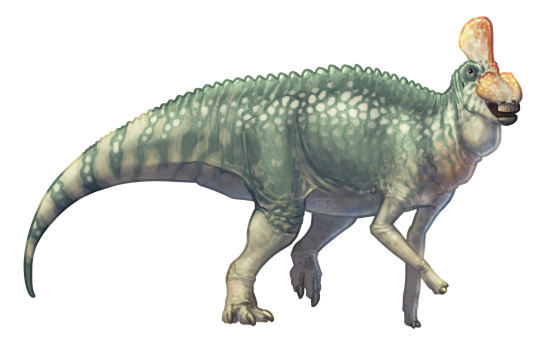

Factfiles:
Ajnabia odysseus

Artwork by @i-draws-dinosaurs, written by @zygodactylus
Name Meaning: Great Seafarer Stranger
Time: 68 to 66 million years ago (Maastrichtian stage of the Late Cretaceous)
Location: Upper member of the Couche III Formation, Ouled Abdoun Basin, north-central Morocco
Ajnabia is an extremely small (possibly the smallest) hadrosaur, specifically a European lambeosaurine. Finding one in Morocco was a legitimate surprise discovery, since northern Africa was fully separated from Europe by ocean at the time. Known from parts of the jaw, most of what we know about it is inferred from its probable close relatives, the North African-European Maastrichtian hadrosaurs - though the crests of these animals are not well known, it is presumable they for the group would have been hollow and shaped in different ways to produce different sounds based on species, including Ajnabia. As in other hadrosaurs, it would have been robust, with long robust and stiff tails, muscular hind limbs with three toed feet, and strong slender forelimbs ending in weird hoof-like structures. They also had rows and rows of densely packed teeth built for grinding through a variety of vegetation. It probably got from Eurasia to Africa via oceanic dispersal, possibly even swimming from one landmass to another. At less than four meters long, it would have been dwarfed by its newfound neighbors, large dinosaurs such as the abelisaurid Chenanisaurus, and a yet-unnamed titanosaur. There were also, of course, azhdarchids in the form of Phosphatodraco and pteranodontid Tethydraco, and three separate types of Nyctosaurids - Alcione, Simurghia, and Barbaridactylus (you may recognize this lineup from a certain paleo doc). On the ocean side of things, mosasaurs, elasmosaurs, sharks, fish, and other marine life filled the seas to the brim, making it even more of a wonder that Ajnabia got over to Morocco safely!
Tlatolophus galorum

Artwork by Joaquin Eng Ponce, written by @zygodactylus
Artwork by Joaquin Eng Ponce, written by Meig
Name Meaning: Gazra and López’s Word Crest
Time: 73 million years ago (Campanian stage of the Late Cretaceous)
Location: Cerro del Pueblo Formation, Coahuila, Mexico
Tlatolophus was a Lambeosaur - so another crested hadrosaur - from Mexico, a place that we don’t talk about the fossils of nearly enough! The most complete Lambeosaur known from Mexico, the skull and large portions of the skeleton are known, including the tail. At about 8 meters long, Tlatolophus had a tall skull and thick tail, and the usual hooved front feet of hadrosaurs. Its crest was long, low, and angled backwards, much like the glyph for “word” in Aztec writings - hence its name! Given the unique shape, it probably made a unique sound, different from other hadrosaurs. Interestingly, it actually seems to have been closely related to Parasaurolophus and its relatives, making it another member of the Parasaurolophini group! As a hadrosaur, it would have been a social animal, with behaviors such as communal nature and communication. The Cerro del Pueblo formation was a coastal ecosystem, filled with a variety of unnamed dinosaurs, but also Coahuilaceratops, Kritosaurus, Latirhinus, Velafrons, Paraxenisaurus (the first potential Deinocheirid from North America), as well as pterosaurs, turtles, fish, and multituberculate mammals.
DMM Round One Masterpost
#dmm#dinosaur march madness#dmm round one#dmm rising stars#palaeoblr#dinosaurs#paleontology#bracket#march madness#polls#ajnabia#tlatolophus
106 notes
·
View notes
Text
I'm developing an ARPG!
To those unfamiliar with the concept ARPGs (Art Role Playing Game) are groups in which you draw/write about your characters for that group doing various things to take part in and complete various activities such as breeding, questing and fighting. Epoch is planned to feel overall similar to ARPGs such as Dracostryx, Kukuri, Primeval-Age, Souls-Between and others like these.
Epoch is an ARPG focused on extinct reptiles from Mesozoic Eurasia specifically, such as dinosaurs and pterosaurs. It will have a variety of fun features such as genetics and mutations, traits that influence performance in different areas and a unique approach to herd/pack groups and questing that aims to encourage players to develop the personal story of their animals. Epoch is being developed with a semi-realistic angle in mind, with the visuals and gameplay both being influenced by reasonable speculation for the species involved.
The first 6 species that will be available to players are ones specifically chosen that were important and influential to paleontological history: Velociraptor, Protoceratops, Megalosaurus, Iguanodon, Pterodactylus and Ichthyosaurus. More species are planned for later updates once the game is released.
I can't give any concrete dates on when Epoch will finally be ready to play, as it is still fairly early in development. While the bases are done there is still a lot of work to be done on the art side of things to get all the assets and guides ready, along with setting up the website that Epoch will be hosted on using the Lorekeeper framework. However I intend to update regularly on development progress over on this blog here @epocharpg so please follow if you want to see more about this project. I've already posted the first dev update over there!
In the meantime, here's a sneak peak of the bases for the starter species!
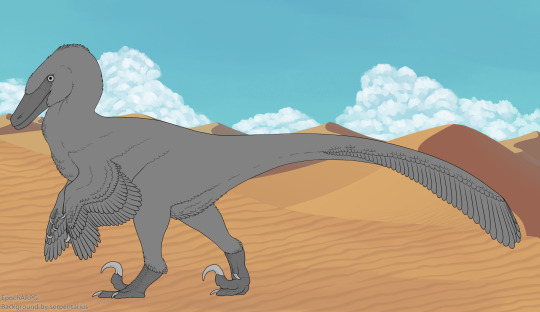





34 notes
·
View notes
Text
The fact that Mexican wolves are critically endangered really breaks my heart. This unique animal, descendants of the very first migrations of wolves into north america from eurasia, that once lived across northern mexico and the southwestern usa, is mostly gone. This is their current range- there are only 241 wild wolves in the usa, 45 in mexico
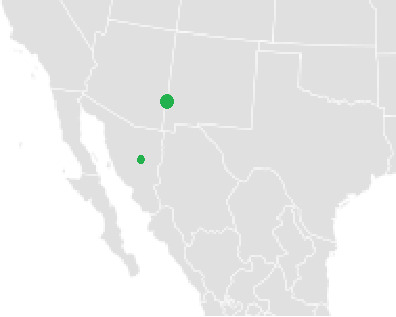
And in usa they are still systematically killed to appease ranchers, in 2018-2019 the feds killed an entire pack of mexican wolves 🤡
26 notes
·
View notes
Note
I'm scared to share Wolf Fun Facts because I'll feel stupid (or like im treating you like YOU'Re stupid) if you already knew the fact 😓 here goes nothing...
it's actually a Not wolf fun fact but in early 2021 genetic analysis suggested that the "dire wolf" may closely match gray wolves anatomically because they just so happened to both evolve that way... independently of each other.
To note: the average "dire wolf" was the same size as the bigger subspecies' of gray wolves today-- their size is greatly exaggerated in fantasy. They didn't have identical proportions to wolves however; with larger skulls, thicker necks, and smaller paws.
"Dire wolves" and ancient gray wolves were not related-- the "dire wolf" is not even of the genus Canis.
Its updated name is Aenocyon dirus, which was actually proposed but largely rejected as its name 100 years before its recent revival and acceptance, and multiple subspecies have been identified. Its closest living relatives are African jackals, and many paleoartists color and pattern Aenocyon dirus similarly due to their apparent shared niche in warm regions.
They preyed upon a few select megafauna, whereas gray wolves hunted a variety of animals that were usually not as large and were more omnivorous-- this is regarded as the reason for the skeletal (and presumably muscular) differences between the two species.
This is also regarded as one reason as to why wolves survived the ice age and Aenocyon did not-- they were better able to adapt with the mass extinction of megafauna as the last glacier period receded because they were already more flexible in their diets. Skeletal evidence demonstrates increasing malnutrition in "dire wolves" over time.
Locations and frequencies of fossils, alongside the close anatomical match, still suggest that "dire wolves" lived similar lifestyles in similar social structures to gray wolves, though in larger packs, despite differences.
Their closest common ancestor evolved in the Americas around 6 million years ago-- for reference on how far removed that ancestor is, the oldest known Aenocyon fossil is 0.25 million years old. One population migrated to Eurasia and the other remained in America. The Eurasian population came to yield the ancient gray wolves from which the modern gray wolf is descended. The American population, meanwhile, gradually gave rise to the "dire wolf".
One (1) "dire wolf" fossil has been found in Asia, suggesting that a very small population of them migrated from the American continents.
A population of the gray wolves eventually migrated to the Americas and lived in loose competition with Aenocyon until the latter went extinct.
Also, another canid called Xenocyon entered North America just before the emergence of "dire wolves" and was the same size, but their fossils on the continent are rare, suggesting Aenocyon very quickly outcompeted them. Xenocyon would later bring about dholes and African painted dogs in Eurasia and Africa.
here's to hoping you didn't know at least something here because much of it is very recent 🥂
!!! i didnt know ANY of that! woah!! convergent evolution is awesome. i always just assumed dire wolves were ancestors of grey wolves. awesome fact ty for informing me!!!! *_*
59 notes
·
View notes
Text
I'm redownloading Planet Zoo today 😃
Kinda burnt myself out on gaming a while back by playing Baldur's Gate 3 with my Husband nonstop after it came out, right after playing Valheim with him nonstop for a while. So it's been a bit since I actively wanted to game. Kinda getting the bug to play again finally, and I really want to play Planet Zoo again because I love it so much.
Bonus points for 2 packs (Eurasia and Oceana) being released while I was away. So now I get to add 2 new packs to my collection, and go in with a fresh zoo.
5 notes
·
View notes
Text

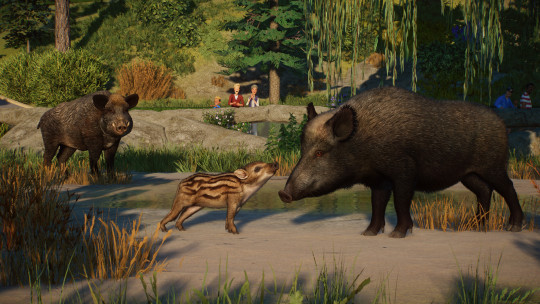

Some of the animals from the new Eurasia Pack - the Wisent, Wild Boar, and Wolverine. I really love how the boars look - their eyes are stunning!
41 notes
·
View notes
Text
Growlithe & Arcanine
Growlithe (#058)
Ignuscanis ignuscanis domesticus ([OG] Growlithe)
Ignuscanis ignuscanis ceroferus ([H] Growlithe)
General Information: The Scout/Puppy Pokémon, Growlithe is a much-beloved fire-type Pokémon with a powerful sense of smell and an impeccable memory for remembering smells. Be careful though, because a particularly pungent and horrid smell will knock out a Growlithe’s sniffer for several days!
Growlithes have two official regional forms: the (OG) Growlithe and the (H) Growlithe. (OG) Growlithe averages at 2’4 feet tall (0.7 M) and 41.9 pounds (19) kg, and (H) Growlithe is slightly larger at 2’7 feet tall (0.8 M) and 50 pounds (22.7 kg).
Careful, the horns on (H) Growlithe are quite breakable!
Habitat: Growlithes are most commonly found in grassland environments around Europe and Asia. They can be found in highland regions, though they tend to stick to the steppes. Growlithes can be found in sparse forests and savannahs, but they are most comfortable in grasslands. Of course, Growlithes are found in pretty much any urban center in Eurasia and most of the world thanks to humans.
Life Cycles: Growlithes are dogs. They have dog life cycles. A captive Growlithe will live for about 20 years and reach reproductive maturity at 2 years old (and level 15). Adults enter estrus throughout the year, though in the wild it tends to occur during the winter. Pups (litters of 3-4) will be born in the mid Spring, and juveniles start being able to hunt and contribute to the pack around the onset of winter.
Growlithes follow the migrations of grassland herbivores, including reindeer (Stantler, Wyrdeer). There is no difference in life cycle between the two regional forms.
Behavior: Growlithes are hypersocial animals that form small to large packs with other Growlithes and Arcanines. They hunt in groups, though Growlithes will usually focus on smaller prey like Deerling while Arcanines focus on Sawsbucks or Wyrdeer. They are also incredibly territorial, meaning they will battle any territory dispute that they even think that they can win. They are fiercely protective and loyal to their pack, and pups are raised communally. There is no true hierarchy, other than Arcanines are bigger, faster, stronger, and wiser than Growlithes, and of course children listen to their parents. While the two parts of the packs tend to hunt different things, the combined efforts of both ensure that everyone is fed. Growlithes learn from the Arcanines in the pack, and in smaller packs with fewer Arcanines, there is more likely to be co-ed hunting parties.
(H) Growlithes in particular have a different approach to cooperation, and will form pairs of watchdogs over anything that they need to guard. They are highly social with each other, but with humans (H) Growlithes are significantly less domesticated than (OG) Growlithes, and can be difficult to tame.
Diet: Meat. Growlithes are carnivores. While specifically (OG) Growlithe has been selectively bred over the millennia to have a more omnivorous diet to tolerate grains and root vegetables, (H) Growlithe has not had these selective pressures from humans and retains its full carnivory. Yes, I know your Growlithe is giving you its best Baby-Doll Eyes, and no, you really shouldn’t give it the cheeseburger in your hand… ah, what the heck, have at it!
Conservation: Endangered ([H] Growlithe), Least Concern ([OG] Growlithe)
Relationship with Humans: Growlithes have an incredibly long history of cooperation with humans, with fossils that date all the way back into the Ice Age. They have been one of humanity’s earliest hunting companions, right alongside other Dog Pokémon and Eevee. Their fierce loyalty is a valued trait that sees them in the service of humans since time immemorial, and their intelligence makes them incredibly useful in all facets of civilization. They make top-notch service dogs, therapy dogs, they’re excellent with children, they make great starter Pokémon, and they’re great to train. Growlithe is the dog among dogs, matched in love only by Lillipups and Eevees. Security forces, detectives, and search-and-rescue parties utilize Growlithes for their keen senses of smell.
In media, Growlithes proliferate alongside Lillipups. A good rule of thumb, is that in media produced by Europe or Asia, it’ll be Growlithes/Arcanines as the stand-in dogs, and in the United States and Canada, it’ll be Lillipups/Herdiers/Stoutlands.
Growlithes make excellent starter Pokémon, but they are considered an exotic species in the Western hemisphere, and only Certified Breeders are allowed to breed them (if at all). This does not stop black markets and feral populations from running amok, but the illegality of Growlithe breeding is one of many conservation efforts in place to punish animal abusers and keep breeding populations strictly in captivity.
Mechanics Reminder: Many excellent breeders will be happy to provide a Growlithe for your North American child, but remember that these Growlithes will be fully sterilized. The failure to do so could result in a huge fine on the part of the breeder.
(H) Growlithes have a different relationship with humanity. While they are certainly cute, they are shy and wary of humans. Scientists speculate that the proto-(OG) Growlithes were a separate lineage from the one that became the (H) Growlithes, and it’s possible that sub-speciation had already occurred within the Growlithes by the time humans began domestication.
Classification: Growlithe is in the genus Ignuscanis which means “fire dog.”
Arcanine (#059)
Ignuscanis agrestis domesticus ([OG] Arcanine)
Ignuscanis agrestis ceroferus ([H] Arcanine)
General Information: Arcanines are the evolved form of Growlithe! Their immense speed and agility is powered by an internal flame that burns constantly. They are capable of running three hundred miles in a single day if given the right motivation.
(OG) Arcanines average at 6'3 feet tall (1.9 M) and 341.7 pounds (155 kg), and (H) Arcanines are 6'7 feet tall (2.0 M) and 370.4 pounds (168 kg).
Habitat: Arcanines are found in the same places as Growlithes.
Life Cycles: Arcanines are just Really Big Dogs with dog life cycles, however a key difference between itself and Growlithe is that Arcanines are known to live an average of 35 years in captivity.
Behavior: There are not many Arcanines in the wild, since they require a Fire Stone to evolve, but those that do exist are fierce protectors of their packs. They are incredibly fast, but do not mistake their ability to run far and fast as an ability to maintain that all the time. A long run or quick sprint still wears out an Arcanine, and such extreme endeavors should be reserved for hunting or fleeing danger.
Diet: (OG) Arcanines are carnivores with a tolerance for an omnivorous diet courtesy of human domestication. (H) Arcanines do not have this trait, and are pure carnivores that only occasionally consume berries or leaves for digestive purposes. Trainers, purchasing some dog food from the store should suffice for your (OG) Arcanine, but perhaps a more intensive meat-focused diet for your (H) Arcanine. Actually, your (OG) Arcanine would love that, too!
Conservation: Endangered ([H] Growlithe), Least Concern ([OG] Growlithe)
Relationship with Humans: Arcanines have been the subject of awe and wonder for a thousand generations. They are beasts of legend and myth, creatures that can run a thousand miles across the globe in a single day. Many cultures use them as signifiers of protection and good luck. Even (H) Arcanines, who are wild and free of human domestication, are still seen as loyal protectors, given the same reverence as (OG) Arcanines. In parts of Eastern Asia, Arcanines and Growlithes are depicted in statues in front of homes and temples as protectors.
In modern media, (OG) Arcanines are primarily the fierce defenders of townships and households, or the majestic creatures that glide across grasslands at breathtaking speeds.
(OG) Arcanines serve many functions in human society, from companionship to hunting, herding to childcare, service dogs to therapy dogs, Rangering to dragon hunting. In contrast, (H) Arcanines are not depicted nearly as much in media, often going unknown to the general populace, though make good companions, too, once they have warmed up to their trainer.
Classification: Arcanines are given the species epithet “agrestis” meaning “wild.” (OG) Arcanine has the sub-species modifier “domesticus” while (H) Arcanine has “ceroferus.” In combination, (H) Arcanine’s species name means “horned, wild, fire dog.”
Evolution: Arcanines evolve from Growlithe with a Fire Stone or other equivalent magical source.
#pokemon#growlithe#arcanine#hisuian arcanine#hisuian growlithe#pokemon biology#pokemon irl#pokemon biology irl#pokemon biology irl tabletop#pokemon tabletop#pokemon irl tabletop#tabletop#tabletop homebrew#homebrew#ttrpg#dog days of summer
12 notes
·
View notes
Text
GENUS: HOMOTHERIUM
Common name: “Scimitar cat”

LONGEVITY: About 4 million years
DISTRIBUTION: Extensive (North America, South America, Eurasia, Africa)
NOTABLE ATTRIBUTES:
Short, strong saber teeth capable of both gripping and stabbing
Large, powerful incisor teeth that interlock to create a vice or beartrap bite
Evidence suggests pack hunting behavior and caching food for later, implying high intelligence
Non-retractile claws grant increased traction and speed when running
Gracile body with hyena-like proportions which allows for high-speed pursuits
Huge eyes and nasal passages similar to modern cheetahs, creating excellent vision and increased oxygen intake when sprinting
Bite force comparable to modern cats (much higher than the “dirk-toothed” sabercat lineage)
WEAKNESSES:
Physically smaller and weaker due to slender build
Unable to do severe damage with paw swipes or climb efficiently, due to non-retractile claws that become worn down when running
A very formidable group with an impressive paper record, homotherium cats may not be the biggest, but certainly have a strong argument for being the baddest. Their near global distribution and relatively long run is a testament to their efficiency as pursuit predators. As another testament to their effectiveness, isotopic analysis of their bones show that they were regularly killing and eating mammoths, one of the largest animals in any terrestrial ecosystem. All of this suggests that they operated in coordinated groups as a well-oiled killing machine. Even in areas where they had to contend with bigger, nastier cats like lions and smilodon cats, homotherium established themselves as capable and efficient predators. However, due to their overall lack of bulk and raw power, they often found themselves as less than apex predators, and most species were overshadowed by their bigger, meaner felid cousins.
I give the homotherium genus the rank of A Tier.
21 notes
·
View notes
Text
OCs As Poisonous Plants
Thank you @vox-monstera for the tag! <3 I actually really love dress up games lol, they're fun.
Rules: create a look-book for one (or more) of your ocs using this meiker and then take this uquiz and share their results.



Grandpa V in a couple of different fits. Deep down she just wants to be comfy and curl up into a little ball in oversized clothes. I also just realized she'd totally be down for fanny packs, extra pocket space for grenades and snacks.
Lily Of The Valley
This is the poison of giving too much. You feel yourself emptying out, dizzying, discoloring-- until you fear you will fade entirely and wither away. You have always had to give. You never had a choice before. They pluck your flowers for their beauty, they trample your leaves carelessly, they pull out your roots by the fistful and berate you for daring to grow. And now that you have a grove to spread out in, your rhizomes tangle and curl in on themselves. When cruelty is all you've ever known, thriving seems impossible. But the answer is not to make yourself small and offer every lovely thing you are to the world in the hopes it will have mercy on you. The answer is to let yourself dare to thrive for thriving's sake, to grow in the wild ways you wish to-- and to do that for yourself for once.
Too tired to tag rn lol. Do the thing if you want! Follow your heart!
Being a plant nerd below the cut.

Lily of the Valley - Convallaria majalis - Is a flowering plant native to Europe and Eurasia (there's another species Convallaria pseudomajalis, which is native to North America), and are members of the asparagus family! While often cultivated in gardens for their beautiful flowers and fragrant scent, they are highly poisonous and contain high amounts cardiac glycosides, which are toxic to humans and other animals if ingested. Poisonous compounds found in plants are defensive mechanisms to help reduce herbaceous grazing from animals.
#tag you're it#reindeer games#meiker game#poison#kuzco's poison the poison specifically designed to kill kuzco#kuzco's poison#character studies#character design#poisonous plants#personality quizes#oc: valerie hye jin li#my grandpa v#stinky not fresh
10 notes
·
View notes
Text
The grasslands of Europe are a collection of areas with sparse tree cover spanning the interiors of the Iberian, Italian, Balkan and Anatolic peninsulas in the south and the plains north of the Black and Caspian Sea in the north, plus a dozen pockets between the forests of central and western Europe.
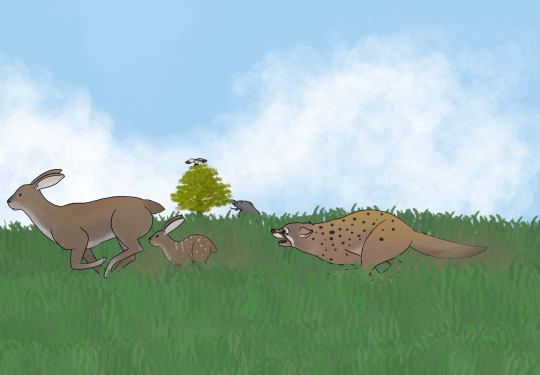
As the name implies they’re dominated by low and high grasses, along with the occasional bushes and the many wildflower species. Trees are pretty sparsely distributed, and the most successful family here are the Querceae, the descendants of oaks and chestnuts.
The most common browsers are the Elepharrhinidae family, a group descended from modern wild boars. They’ve developed a proboscis from their snout and longer tusks. They aren’t strict browsers and up to half of their diet can be grass.
An another heavy-set clade are the Moschystricidae, strict grazers that evolved from Italian and north-african porcupines, that lost most of their quills, except for a mane around their necks and on their tail, in order to scare off and harm predators and rivals
The faster and lighter herbivores are the descendants of the running hares that evolved in the earliest Epigene, like Metalagus, that grew in size and became, in some cases, as tall as 2 metres, but most species average around 1,50 metres.
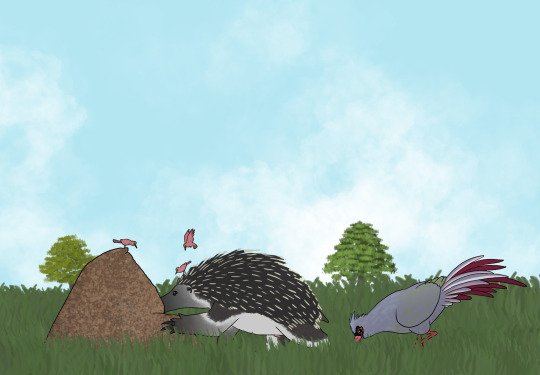
Mound building termites expanded from Africa into south-western Europe, opening the doors to a kind of animal Europe had been devoid of for millions of years: myrmecophages. An unlikely candidate took on this role, the hedgehog, that developed long jaws, a long sticky tongue, big sharp claws and knuckle walking, resembling a placental echidna. With their pointy quills and massive claws, even though they’re not really fast or agile, they’re an unlikely prey to the many predators of the grasslands, and are used as protection by similar sized critters, like phasianids and the still hopping rabbits.
Canids survived through the mass extinction, and thanks to their adaptations were able to quickly radiate into various forms. The main groups of the european grasslands are the Thocyon genus, pack hunters that exhaust their prey to kill it, and the Cinocyon genus, cheetah-like canids that are some of then planet’s fastest animals, both descended from the golden jackal.

(She’s based off my friend’s cat)
The apex predator of these areas, tho, is the Fellimus alexandrae, a big ambush predator capable of reaching 200 kg, that evolved from European wildcats, with around 10-20% of their ancestry coming from housecats. The genus is widespread across Eurasia, and this species is represented by three subspecies: the F. alexandrae alexandrae, from Southern Europe, slightly smaller than the other two and with shorter fur; the F. alexandrae auduli, from the pockets of grassland in Central Europe; and the F. alexandrae aikoja, from the northeastern plains and into Central Asia.
#spec evo#spec bio#speculative evolution#speculative biology#future evolution#future earth#worldbuilding#epigene period#artwork#digital art
37 notes
·
View notes
Text
youtube
🦢 Yeah! Planet Zoo Eurasia Pack est maintenant disponible ! 🦢







2 notes
·
View notes
Text
Untitled Wednesday Library Series, Part 97
While I crunch away at my definitely non-school-related entirely personal winter reading, let’s have an easy thing in the shape of an Atlas of Ancient History. Written/curated/edited by Michael Grant with cartography by Arthur Banks, it was first printed by Macmillan in Britain as the 1971 Ancient History Atlas, but was revised and run off by the New York-based Dorset Press in 1985 under this title. I feel very little toward it.



The How
I’ve misremembered for years that I got this while visiting some friends in Kent. In fact I seem to have bought it closer to home; there’s a secondhand price tag in USD and it’s a domestic printing anyhow. I know for sure I got my Folio Society The Persians in Canterbury. These feel similar but different in that they’re both dark blue this one is vaguely cruddy. You’ll forgive me for unconsciously conflating them, I trust.
The Text
Sensu stricto there isn’t much. Titles, legends, pointers, notes. This is 98% map by dry weight.

I’ve included pictures of some more unusual ones, but it’s mostly standard fare. Rome, Greece. Bit of Turkey. There’s one that focuses on China, but (gasp) in this case ‘ancient history’ means ‘the antique Mediterranean and a bit of greater Eurasia when it’s easy’.
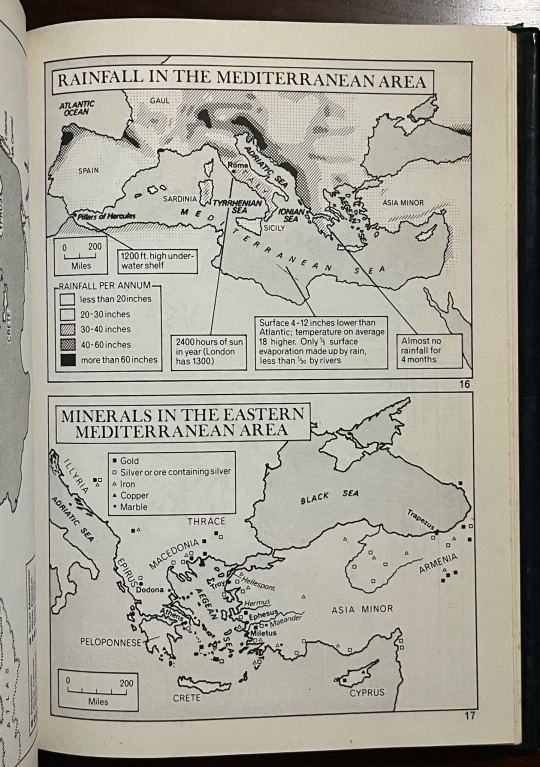
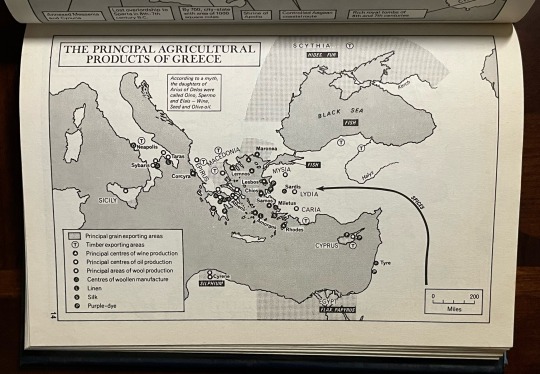

Whatever, man. What’s here is quite well realized — good detail work, strong visualizations, reasonably readable — but the, um, narrow focus telegraphed by the cover isn’t inaccurate. If this was anything like comprehensive about anything other than the Mediterranean Basin I’d be more impressed.
The Object
As I say, kinda cruddy. Acid-nibbled paper, thin boards, slightly loose binding. Nice to look at but the size of it feels wrong. Good printing, I admit, and Banks’ work is enviable.
The Why, Though?
If this is a question about purchasing: Since when have I been answerable for past me’s judgment? Don’t answer that.
If this is a question about shelving: This was the very last book I grabbed from storage when packing for the most recent move. It fit nicely in an empty spot in a file box and protected by good art books from bouncing. Also it’s maps. I like a map/graph/chart. It is known.
13 notes
·
View notes